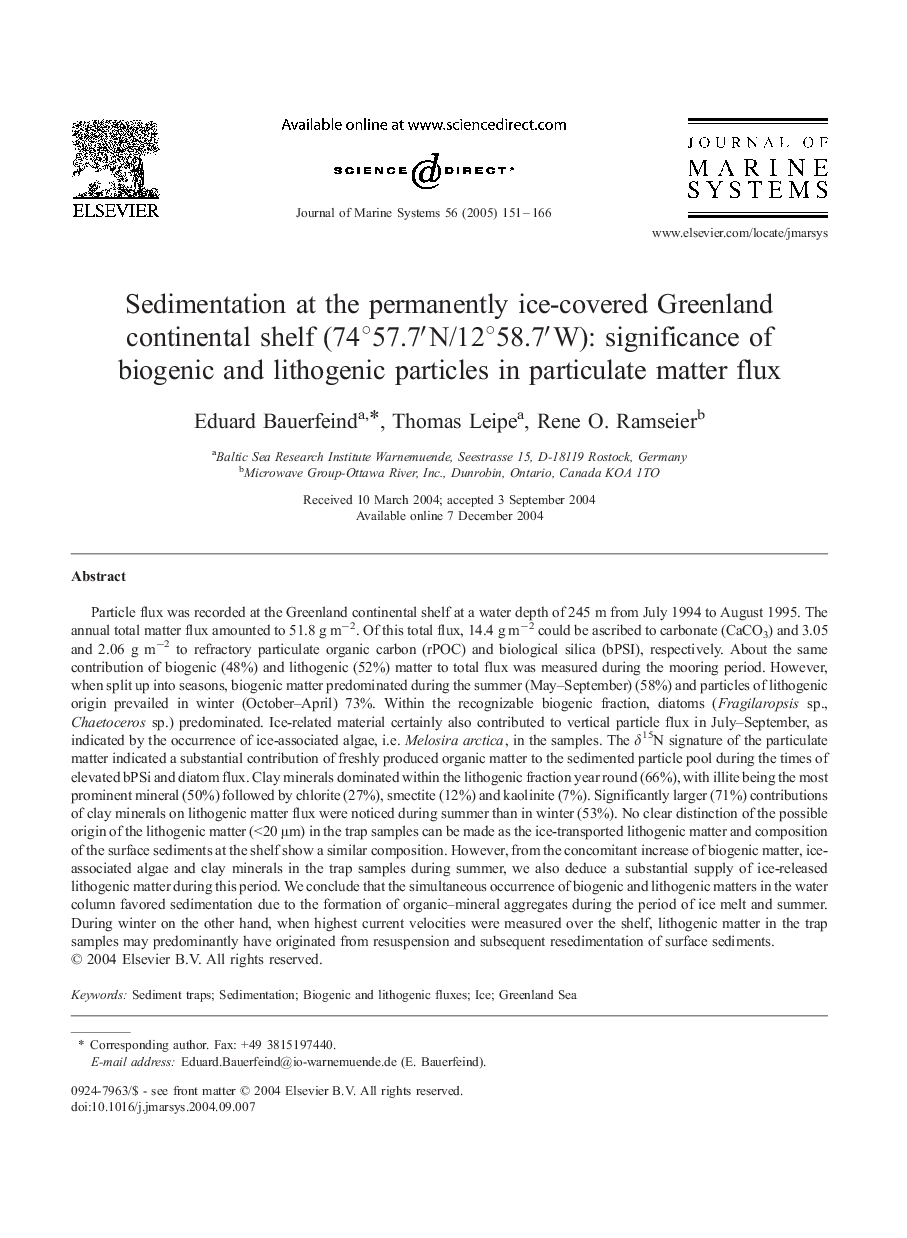| کد مقاله | کد نشریه | سال انتشار | مقاله انگلیسی | نسخه تمام متن |
|---|---|---|---|---|
| 9483535 | 1627375 | 2005 | 16 صفحه PDF | دانلود رایگان |
عنوان انگلیسی مقاله ISI
Sedimentation at the permanently ice-covered Greenland continental shelf (74°57.7â²N/12°58.7â²W): significance of biogenic and lithogenic particles in particulate matter flux
دانلود مقاله + سفارش ترجمه
دانلود مقاله ISI انگلیسی
رایگان برای ایرانیان
کلمات کلیدی
موضوعات مرتبط
مهندسی و علوم پایه
علوم زمین و سیارات
اقیانوس شناسی
پیش نمایش صفحه اول مقاله

چکیده انگلیسی
Particle flux was recorded at the Greenland continental shelf at a water depth of 245 m from July 1994 to August 1995. The annual total matter flux amounted to 51.8 g mâ2. Of this total flux, 14.4 g mâ2 could be ascribed to carbonate (CaCO3) and 3.05 and 2.06 g mâ2 to refractory particulate organic carbon (rPOC) and biological silica (bPSI), respectively. About the same contribution of biogenic (48%) and lithogenic (52%) matter to total flux was measured during the mooring period. However, when split up into seasons, biogenic matter predominated during the summer (May-September) (58%) and particles of lithogenic origin prevailed in winter (October-April) 73%. Within the recognizable biogenic fraction, diatoms (Fragilaropsis sp., Chaetoceros sp.) predominated. Ice-related material certainly also contributed to vertical particle flux in July-September, as indicated by the occurrence of ice-associated algae, i.e. Melosira arctica, in the samples. The δ15N signature of the particulate matter indicated a substantial contribution of freshly produced organic matter to the sedimented particle pool during the times of elevated bPSi and diatom flux. Clay minerals dominated within the lithogenic fraction year round (66%), with illite being the most prominent mineral (50%) followed by chlorite (27%), smectite (12%) and kaolinite (7%). Significantly larger (71%) contributions of clay minerals on lithogenic matter flux were noticed during summer than in winter (53%). No clear distinction of the possible origin of the lithogenic matter (<20 μm) in the trap samples can be made as the ice-transported lithogenic matter and composition of the surface sediments at the shelf show a similar composition. However, from the concomitant increase of biogenic matter, ice-associated algae and clay minerals in the trap samples during summer, we also deduce a substantial supply of ice-released lithogenic matter during this period. We conclude that the simultaneous occurrence of biogenic and lithogenic matters in the water column favored sedimentation due to the formation of organic-mineral aggregates during the period of ice melt and summer. During winter on the other hand, when highest current velocities were measured over the shelf, lithogenic matter in the trap samples may predominantly have originated from resuspension and subsequent resedimentation of surface sediments.
ناشر
Database: Elsevier - ScienceDirect (ساینس دایرکت)
Journal: Journal of Marine Systems - Volume 56, Issues 1â2, May 2005, Pages 151-166
Journal: Journal of Marine Systems - Volume 56, Issues 1â2, May 2005, Pages 151-166
نویسندگان
Eduard Bauerfeind, Thomas Leipe, Rene O. Ramseier,